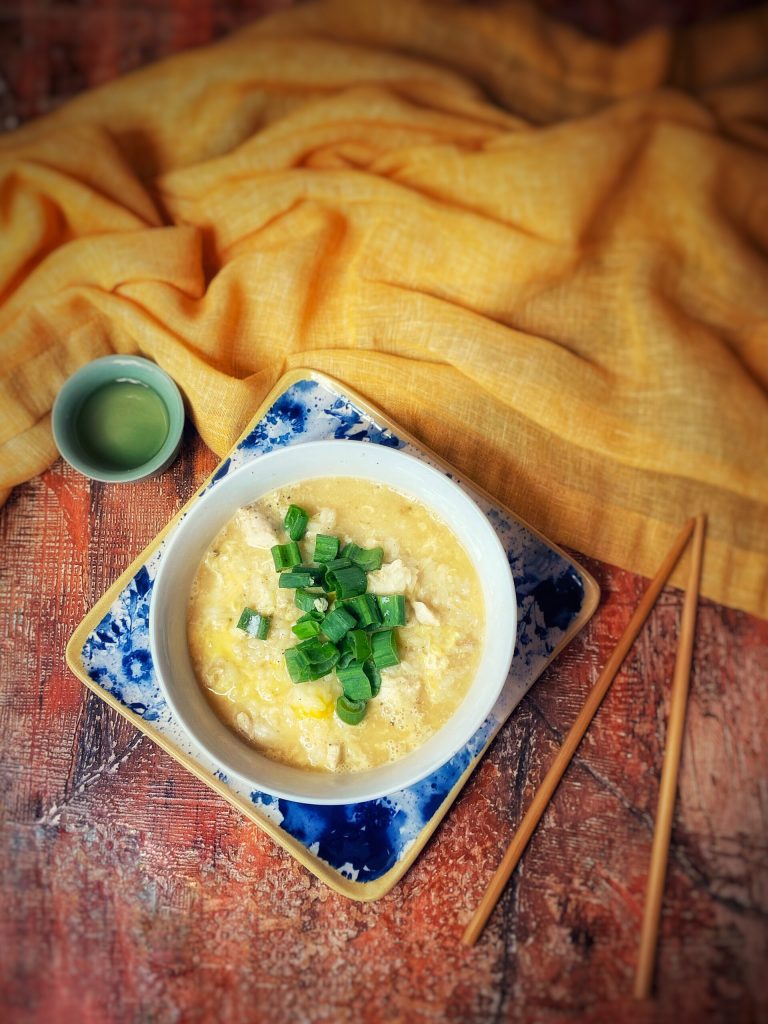▶Zōsui (雑炊, literally “various cooking”) is a rice soup made of pre-cooked rice, dashi broth, soy sauce, and cooked with other ingredients such as meat, seafood, mushrooms, and vegetables, in this case, chicken (Tori zōsui).
It is generally served to those who are sick and only in winter.
Some might describe it as the Japanese version of congee, but Zōsui has a heartier texture. The rice grains are intact while immersed in the soup broth.
There are many variants of Chinese congee: in the Philippines, it is called lugao, although in Spanish-influenced areas it is arroz caldo.
In Korea, the dish is called juk while in Thailand it is known as jok.
In India, it’s ganji, although in Tamil and Kerala it is kanji.
In Vietnam ha chao. And in Indonesia bubur.

- Difficulty: Easy
- Cost: Economical
- Preparation time: 5 Minutes
- Portions: 4 people
- Cooking methods: Boiling
- Cuisine: Japanese
- Seasonality: Winter
Ingredients
- 4 cups dashi broth
- 14 oz chicken (breast is fine)
- 2 teaspoons soy sauce
- 3 cups steamed uruchimai rice
- 2 eggs
- 1 green onion
- to taste salt and pepper
Steps
Bring the dashi broth to a boil, add the whole chicken, and cook for about 20 minutes, skimming off the foam that rises to the surface.
Remove the chicken from the broth, and slice it into strips.
Add the soy sauce to the broth and the cooked rice. Cook for 3 minutes.
Beat the eggs.
Add the chicken back to the broth along with the eggs in a circular motion.
Season with salt and pepper. Cook for 2/3 minutes.
Serve with sliced green onion (green part).

“Flowers are flowers
because they wither,
but luckily the wind”
❤️I dedicate this post to the noble Mariko from @shogunseries a great character from the majestic TV series “Shōgun” (from a novel by James Clavell from 1975) that I recommend you not to miss if, like me, you love Japan, its poetry, its history, its consistency.
FAQ (Questions and Answers)
What are the types of zōsui?
There are different varieties of zōsui, including maru zōsui (まる雑炊) (made with Chinese softshell turtle), fugu zōsui (ふぐ雑炊) (made with pufferfish), tori zōsui (とり雑炊) (made with chicken), kani zōsui (かに雑炊) (made with crab), sukiyaki zōsui (すきやき雑炊), and shabu-shabu zōsui (しゃぶしゃぶ雑炊).
In home cooking, leftover broth and rice are combined with any ingredients available in the house.What is the difference between zōsui and ojiya?
The word ojiya often has the same meaning as zōsui, although it was created as part of the nyōbō kotoba.
Its origins are unclear, although it has been suggested that it derives from the sound produced by cooking rice, or perhaps from olla, the Spanish word for ceramic pots (pronounced oja (オジャ) in Japanese).
Many people use the words ojiya and zōsui interchangeably, and usage varies depending on the region and family.
However, the following list shows some common differences between them:
Zōsui is prepared by rinsing the rice first to increase its stickiness.
In zōsui, the broth and rice are boiled together, preserving the shape of the rice.
With ojiya, the shape of the rice is not preserved when it is boiled together with the broth. The rice grains break up and deform the shape.
While flavored with miso or soy sauce, the broth in ojiya remains light-colored or white. The broth of zōsui, on the other hand, is flavored only with soy sauce.Are Zōsui and Jūshī the same dish?
Jūshī (ジューシー) (originally jūshīmē (ジューシーメー)) is considered derived from zōsui. However, it is generally prepared with raw rice, and a lot more water is used during its preparation.
Strictly speaking, these rice dishes are called kufajūshī (クファジューシー) (or katai jūshī (固いジューシー, literally “firm jūshī”)), and zōsui is yafarā jūshī (ヤファラージューシー) (or yawarakai jūshī (柔らかいジューシー, lit. “soft jūshī”)).
There is a huge variety of styles in which Jūshī is prepared, including using large amounts of lard or margarine.
Commonly used ingredients also include pork ribs, hijiki, carrots, shiitake, and konjac jelly.
Yafarā jūshī contains pork ribs or pork meat, yomogi leaves (フーチバー, fūchibā), potato leaves (カンダバー, kandabā), and taro (チンヌク, chinnuku).What is the difference between zōsui and okayu?
Okayu (sometimes called shira-gayu or kayu) is generally much thicker, although it can be “adjusted” by varying the water to rice ratio.
Compared to the same recipe in other Eastern countries, okayu is much thicker due to the 1 to 5 rice-to-water ratio (Cantonese style congee is 1 to 12). This harmonious proportion is called 全粥 zen-gayu.

